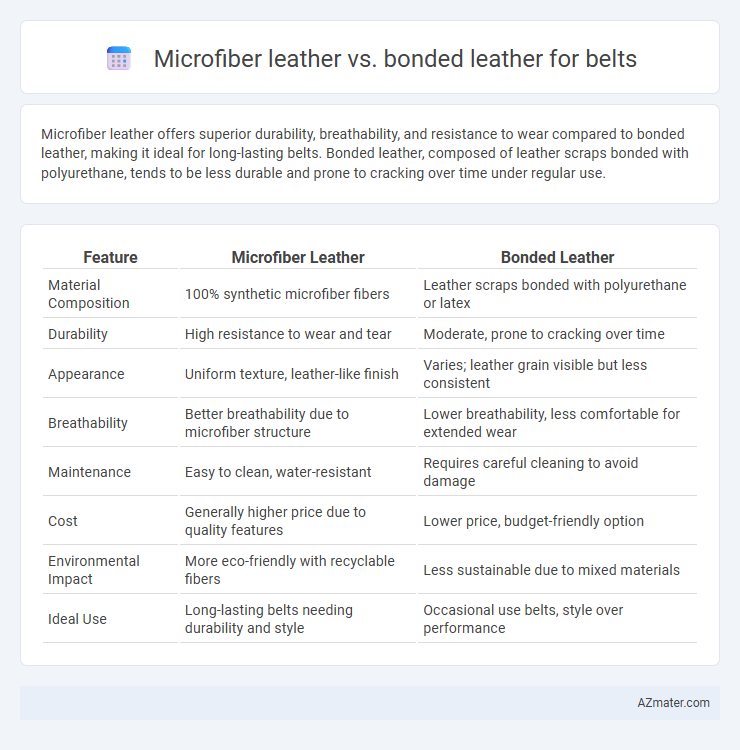Microfiber leather offers superior durability, breathability, and resistance to wear compared to bonded leather, making it ideal for long-lasting belts. Bonded leather, composed of leather scraps bonded with polyurethane, tends to be less durable and prone to cracking over time under regular use.
Table of Comparison
| Feature | Microfiber Leather | Bonded Leather |
|---|---|---|
| Material Composition | 100% synthetic microfiber fibers | Leather scraps bonded with polyurethane or latex |
| Durability | High resistance to wear and tear | Moderate, prone to cracking over time |
| Appearance | Uniform texture, leather-like finish | Varies; leather grain visible but less consistent |
| Breathability | Better breathability due to microfiber structure | Lower breathability, less comfortable for extended wear |
| Maintenance | Easy to clean, water-resistant | Requires careful cleaning to avoid damage |
| Cost | Generally higher price due to quality features | Lower price, budget-friendly option |
| Environmental Impact | More eco-friendly with recyclable fibers | Less sustainable due to mixed materials |
| Ideal Use | Long-lasting belts needing durability and style | Occasional use belts, style over performance |
Introduction to Microfiber and Bonded Leather
Microfiber leather, made from ultra-fine synthetic fibers bonded together, offers high durability and a natural leather look, ideal for belts requiring flexibility and long-lasting wear. Bonded leather consists of shredded genuine leather scraps combined with polyurethane or latex, providing a cost-effective alternative with a leather-like appearance but lower durability. Both materials cater to different market needs, with microfiber leather excelling in performance and bonded leather in affordability.
Understanding Microfiber Leather Composition
Microfiber leather consists of a fabric base made from ultra-fine synthetic fibers, typically polyester and polyurethane, which are layered and treated to mimic the texture and durability of natural leather. This composition provides superior breathability, flexibility, and resistance to wear compared to bonded leather, which is made from scraps of genuine leather mixed with adhesives and artificial materials. Understanding this fundamental difference highlights microfiber leather's enhanced longevity and consistent quality in belt manufacturing.
What is Bonded Leather?
Bonded leather is a material made by combining shredded leather fibers with a polyurethane or latex backing, resulting in a product that mimics the appearance of genuine leather at a lower cost. It is less durable than microfiber leather, which is crafted from finely woven synthetic fibers designed to replicate leather's texture and strength. For belt applications, bonded leather offers a budget-friendly option but lacks the longevity and resistance to wear provided by microfiber leather.
Durability: Microfiber Leather vs Bonded Leather
Microfiber leather exhibits superior durability compared to bonded leather, offering resistance to cracking, peeling, and wear over time. Bonded leather, made by bonding leather scraps with adhesives, tends to deteriorate faster under daily use due to its lower fiber content and weaker structure. For belt applications, microfiber leather provides enhanced longevity and maintains its appearance longer than bonded leather.
Appearance and Texture Comparison
Microfiber leather offers a consistent, smooth texture that closely mimics genuine leather, providing a sleek and refined appearance ideal for high-quality belts. Bonded leather exhibits a more uneven texture with visible imperfections due to its composite nature, often resulting in a less uniform finish. The dense fiber composition in microfiber leather enhances durability and maintains a supple feel, whereas bonded leather may feel stiffer and less breathable over time.
Comfort and Flexibility in Belts
Microfiber leather offers superior comfort and flexibility in belts due to its breathable, soft texture and ability to stretch without losing shape, making it ideal for prolonged wear. Bonded leather, composed of leather scraps and synthetic materials, tends to be less flexible and may become stiff over time, reducing comfort during extended use. Microfiber leather's durability and resistance to cracking further enhance its comfort compared to the often rigid and less adaptable bonded leather belts.
Environmental Impact and Sustainability
Microfiber leather, made from polyurethane applied to a microfiber base, offers greater durability and a lower environmental footprint compared to bonded leather, which is composed of shredded leather scraps bonded with polyurethane or latex. Microfiber leather reduces waste and eliminates the need for animal hides, promoting sustainability with a production process that uses fewer toxic chemicals and generates less pollution. Bonded leather's reliance on recycled leather scraps can lower waste but often involves adhesives and treatments that may release harmful substances, making microfiber leather a more eco-friendly option for belts.
Price Differences and Value for Money
Microfiber leather belts generally cost more than bonded leather due to higher durability and superior water resistance, offering better long-term value. Bonded leather belts are cheaper upfront but tend to wear out faster, making them less cost-effective over time. Investing in microfiber leather provides enhanced longevity and maintains appearance better, ensuring greater value for money despite the initial price difference.
Maintenance and Care Requirements
Microfiber leather belts demand minimal maintenance, requiring only occasional wiping with a damp cloth to remove dirt and prevent stains, and they resist cracking and peeling better than bonded leather. Bonded leather belts need more frequent conditioning with leather care products to maintain flexibility and avoid drying out, and they are more susceptible to damage from moisture and heat. Proper maintenance extends the lifespan of microfiber leather belts, while bonded leather belts often show wear more quickly without consistent care.
Which Leather is Best for Belts?
Microfiber leather offers superior durability, water resistance, and breathability compared to bonded leather, making it ideal for high-quality belts that last longer and maintain their appearance. Bonded leather, made from shredded leather fibers mixed with adhesives, tends to wear out quickly and can peel or crack, making it less suitable for everyday belt use. For long-term value and comfort, microfiber leather is the best choice for belts.

Infographic: Microfiber leather vs Bonded leather for Belt
 azmater.com
azmater.com